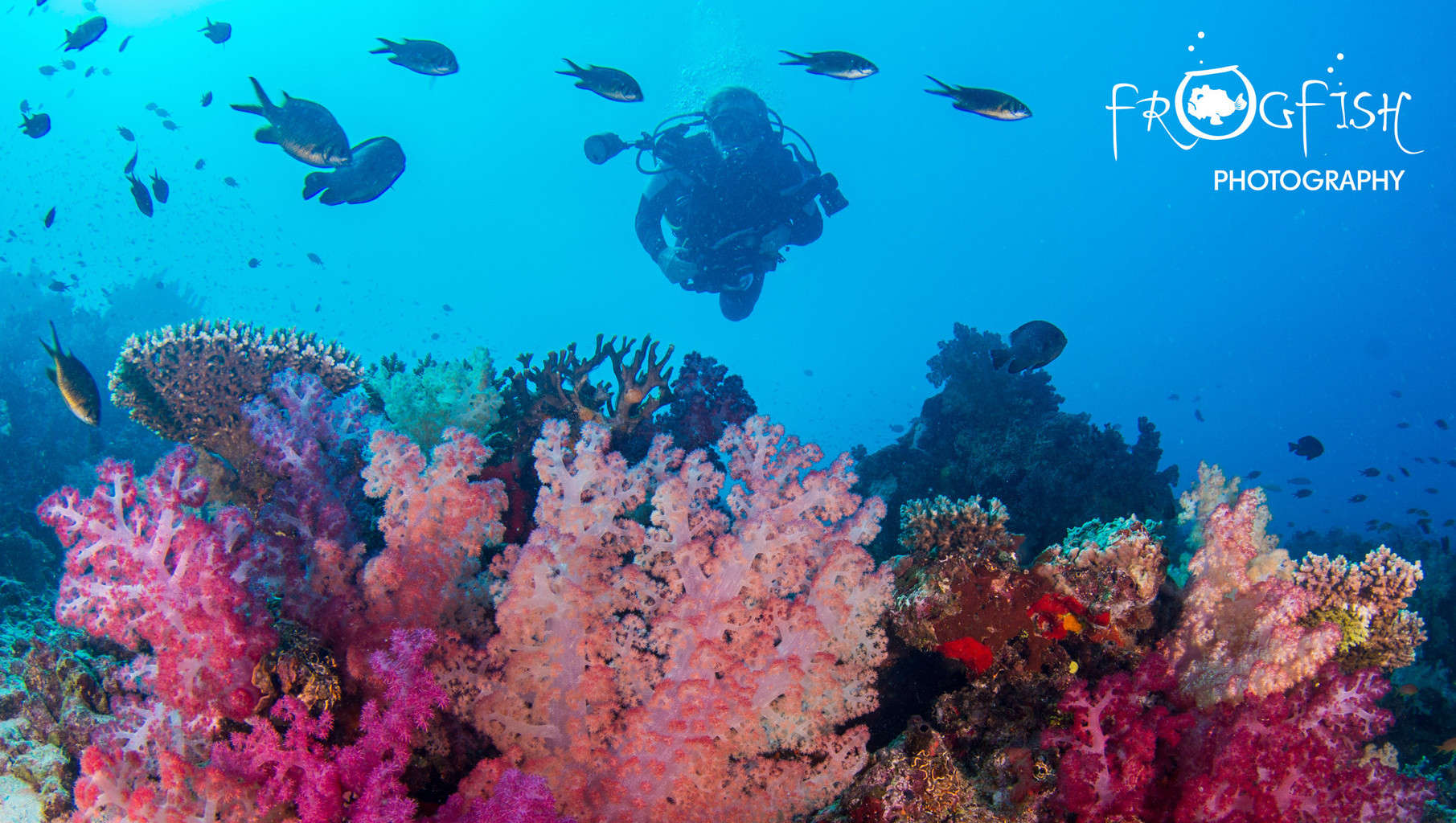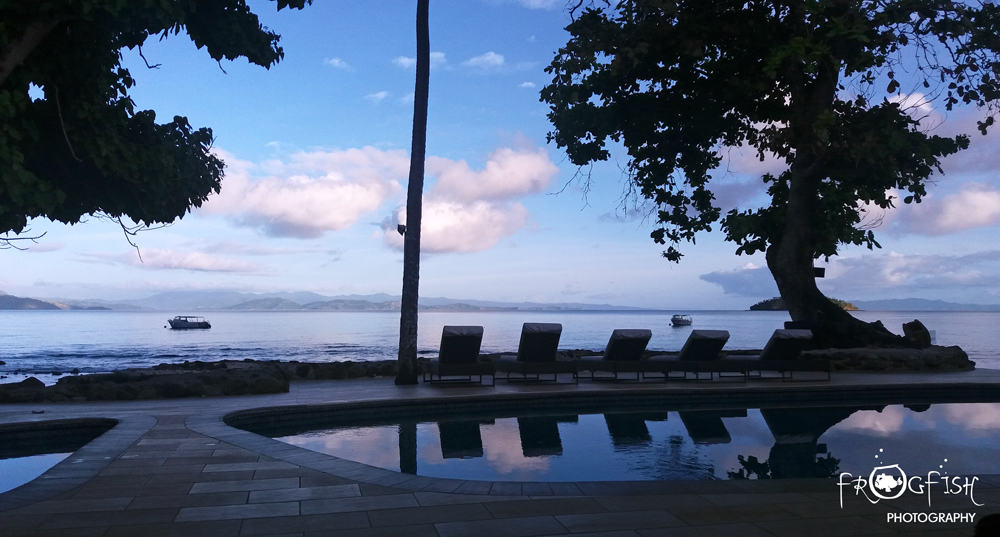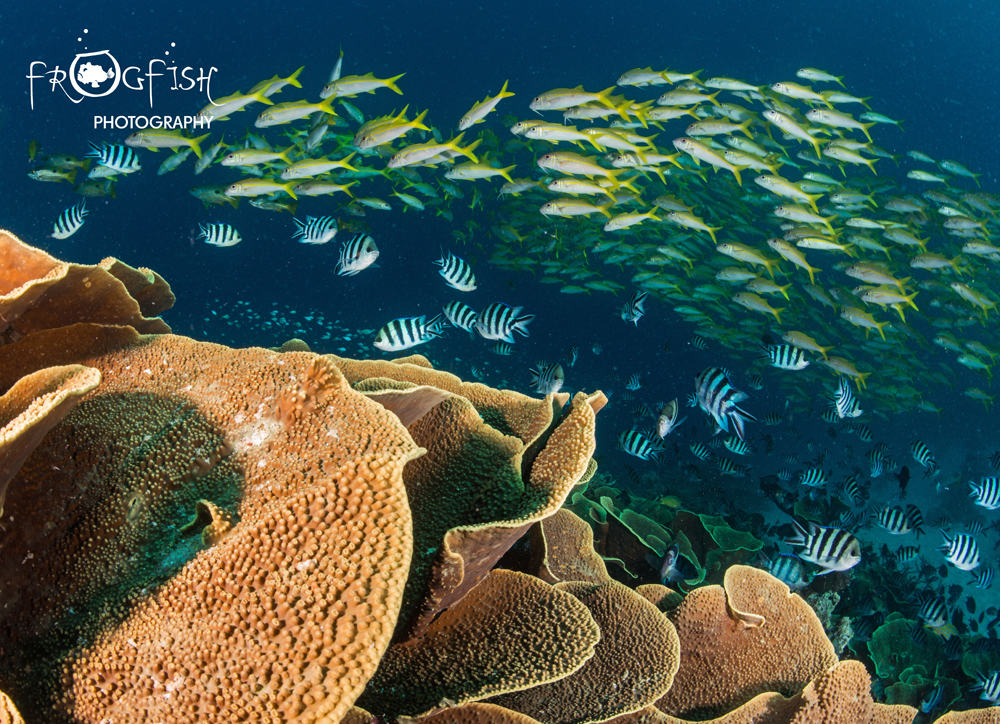News
Tales from Taveuni

Taveuni, the third largest island in Fiji, was to be our first destination on this diving tour of Fiji. As we flew over the mountains of the main island, and then out to sea, over deep blue waters dotted with miles of reef, we knew we were in for a treat. Taveuni is famous for Rainbow Reef, a large reef system with some of the best coral in the world, and we had two days diving to sample it and see if it could live up to our expectations.
 We stayed at the Garden Island Resort, which is located immediately off the beach, with Rainbow Reef right on the doorstep, some 3 – 15 minutes boat ride away (depending on which dive site is on the cards). The hotel has 30 rooms and a dining room with a wonderful view. The food here was fantastic, with Caroline getting a “Vegetarian Surprise” each evening made from fresh veggies grown locally. On our first evening, we wondered what the noise was outside our room as early evening approached. There was a cacophony of squabbling of some kind in the trees, perhaps birds coming into roost, we thought – but we were wrong – it is a huge colony of bats! The Fiji Flying Fox is a large bat with a white patch on the back of its head and the Garden Island Resort is home to huge numbers of them. Look up into the trees, and you can see hundreds of them hanging upside down from the branches during the day, and then flying overhead while you eat dinner in the evening. It is an amazing sight. We were also treated to a silent, close fly-by from a large owl, who swooped elegantly above our table; nature thrives here.
We stayed at the Garden Island Resort, which is located immediately off the beach, with Rainbow Reef right on the doorstep, some 3 – 15 minutes boat ride away (depending on which dive site is on the cards). The hotel has 30 rooms and a dining room with a wonderful view. The food here was fantastic, with Caroline getting a “Vegetarian Surprise” each evening made from fresh veggies grown locally. On our first evening, we wondered what the noise was outside our room as early evening approached. There was a cacophony of squabbling of some kind in the trees, perhaps birds coming into roost, we thought – but we were wrong – it is a huge colony of bats! The Fiji Flying Fox is a large bat with a white patch on the back of its head and the Garden Island Resort is home to huge numbers of them. Look up into the trees, and you can see hundreds of them hanging upside down from the branches during the day, and then flying overhead while you eat dinner in the evening. It is an amazing sight. We were also treated to a silent, close fly-by from a large owl, who swooped elegantly above our table; nature thrives here.
Our room at Garden Island Resort was a real treat. It ticked all our boxes for what makes a great room on a trip: huge glass windows overlooking the ocean, a veranda to sit and relax (and dry out gear), a really good shower and finally loads of surfaces and electric sockets for setting up and charging our underwater photography gear.
 Our diving was with Paradise Taveuni, who picked us up from the so-called Korean Jetty each morning. Their boat, the Taveuni Explorer, is a catamaran, which can hold 30 or so divers, with plenty of space for camera equipment and an upstairs deck for relaxing. In fact, they were running the trips just for us over these two days, and so we had the boat and crew to ourselves. Alan, who owns Paradise Taveuni, a resort and dive operation, joined us so that he could share some of his favourite dives sites with us.
Our diving was with Paradise Taveuni, who picked us up from the so-called Korean Jetty each morning. Their boat, the Taveuni Explorer, is a catamaran, which can hold 30 or so divers, with plenty of space for camera equipment and an upstairs deck for relaxing. In fact, they were running the trips just for us over these two days, and so we had the boat and crew to ourselves. Alan, who owns Paradise Taveuni, a resort and dive operation, joined us so that he could share some of his favourite dives sites with us.
All of our 5 dives would be on Rainbow Reef, and our first dive site was called Rainbow’s End. As with many great soft coral dive sites, there needs to be some current to maintain the healthy reef, and so we knew we would be drifting along with the current on this dive. Whilst this made it harder to get great images, it was worth it to see all the coral in its full glory. Purple, red, yellow, orange, & green: the colours were simply astounding. Every inch of space is taken up with hard and soft corals. As we got shallower and crossed onto the top of the reef, the current died down and we could catch our breath and have a look around. It is not only the coral that is abundant, but the fish life too. Numerous anthias surround every bommie, and schools of fish rush past, seemingly oblivious to the currents, and in the distance, a turtle was grazing. All too soon it was time to come back up to the boat, and compare what we had seen. Rainbow Reef is a dive site that lives up to its name!
Wanting to relax and take a little more time, without the currents hurrying us along, we picked two more sedate dives to fill the rest of our day. Mid Way and Freeway are shallow sites, with sandy areas and plenty of coral to keep us happy. Walter, our dive guide, took us on a slow tour of these sites, pointing out octopus, nudibranchs and other reef inhabitants. Whilst the coastline and resorts were terribly damaged earlier in the year by Cyclone Winston, it was fantastic to see that the main reef was still completely untouched by the storm… and in great condition. Between our second and third dives, we had lunch and a cold drink and chatted away about Fiji, Taveuni and the diving in the area. Paradise Taveuni are based in the South of the island, and regularly get sharks, mantas and even pilot whales and dolphins playing around the boat. It was a great first day of diving and a perfect way to start our Fiji odyssey.
Our second dive saw us visit the most famous dive in the area: White Wall. This is regularly voted into the top 10 lists of wall dives around the word. The reason it is so special is that wall is covered in a white (or pale blue) soft coral- “the nearest Fiji gets to snow”, our captain Maikeli joked. The dive site is reached by descending down a swim through that cuts through the wall and deposits you at 25m into the blue. Turn left, and you see it – a wall stretching deep down into the black, covered in this amazing, almost glowing soft coral. It does indeed look like it has been snowing on the white wall. We drifted along, on a mild easy going current, and watched in wonder at the beauty of this reef, but all too soon, we had to start heading shallower, away from the white coral and back to the “normal” reef. Here overhang and swim-through entrances were lined with an abundance of variously coloured soft corals and sea fans.
The Paradise Taveuni team had really gone out of their way to make sure we saw all the best dives in such a short space of time. As we were flying the next day, they picked us up at 6:30 in the morning to ensure we that could do two dives safely, giving us 24 hours no-dive time before our onward flight in the morning. Our final dive was one of our favourites, a shallow reef called Cabbage Patch. As the name suggests, the reef here is covered in cabbage coral, with huge numbers of fish swimming between the coral fronds, and schooling above the reef too. Nick spent some time becoming one with the schooling fish and was soon in amongst them taking photos. The reef was alive with activity from hunting fish to tiny nudibranchs on their slow commute. In only 10m (30ft) of water, we could have spent many happy hours here.
Back at Garden Island Resort we had a couple of hours free before we had to start packing, so we headed to the International Date Line. The 180 degree meridian is a short (if somewhat hot in the midday sun) walk up the hill from the hotel. We headed across a rugby pitch and were soon able to jump from the present day, into yesterday! Not something you can say very often! We took some photos and headed back to pack up. We then spent a very enjoyable evening with owner, Phil, and his friend Mike, discussing diving, Fiji, politics and life, all the while with the bats bickering and flying overhead. Magic.
Our thoughts from Taveuni as we head on to the next Fiji destination are that this is an island with a wonderful reef, friendly locals, great food, lots of bats and a place that we would love to return to.
Gear News
Introducing the TR-80, IR-50 and CS-30 Regulators from DYNAMICNORD

Whether you are a beginner or a professional diver – with the three new main regulators from DYNAMICNORD, everyone will find their favourite regulator. They all look super stylish.
Excellent performance with the TR-80
Quality and performance are the be-all and end-all for regulators. It is not for nothing that the TR stands for Tec Reg. The innovative design of the TR-80 guarantees absolute reliability – even in ice-cold waters.

Perfect breathing effort at 0.8 J/l / certified for diving in waters below 10 degrees / structural design made of solid brass for best cold protection / membrane-compensated design with dry seal of the first stage / reduced exhalation effort thanks to optimized exhalation membrane and bubble deflector / adjustable Venturi (dive/predive) and adjustment knob for individual inhalation comfort / innovative design of the front cover prevents free-flow in strong currents or when diving with scooters / design made of sandblasted brass, matt chrome finish / 2 HP and 4 LP outlets / mouthpiece made of high-quality, anti-allergic silicone for maximum comfort.


Amazing underwater adventures with the IR-50
The IR-50 is the top regulator for advanced and experienced divers. Natural breathing is the essence of this regulator.

Ideal breathing effort at 0.8 J/l /certified for diving in waters below 10 degrees / compensated membrane / adjustable venturi (dive/predive) and adjustment knob for individual inhalation comfort/ outlet valve and deflector for minimum exhalation effort and reduction of bubbles on the face / design made of sandblasted brass, matt chrome finish / 2 HP and 4 NP outlets / mouthpiece made of high-quality, anti-allergic silicone for maximum comfort.


The Workhorse – our CS-30
For diving centres and diving beginners – the workhorse stands for strong construction, reliability and robustness. Perfect for your training.

Optimal breathing effort at 0.8 J/l /recommended for diving in waters above 10 degrees / non-compensated piston / adjustable venturi (dive/predive) / outlet valve and deflector for minimum exhalation effort and reduction of bubbles on the face / design made of sandblasted brass, matt chrome finish / 1 HP and 3 NP outlets / mouthpiece made of high-quality, anti-allergic silicone for maximum comfort.


Octopus OP-30
The OP-30 is the ideal addition to all DYNAMICNORD regulators. It is identical in construction to the CS-30.

The TR-80, IR-50, CS-30 (DIN & INT) regulators and the Octopus OP-30 are available from DYNAMICNORD dealers and in the online store.
DYNAMICNORD – Your Outdoor Companion.
Marine Life & Conservation
Paul Watson Released as Denmark Blocks Japan’s Extradition Bid

Renowned anti-whaling activist Paul Watson has been released from custody in Greenland after spending five months in detention. Denmark’s Justice Ministry rejected Japan’s request for his extradition, citing insufficient guarantees that his time already served in custody would be credited against any potential sentence.
The 74-year-old Canadian-American was arrested on July 21 in Nuuk, Greenland’s capital, when his ship docked to refuel. His arrest was based on a 2012 Japanese warrant related to a 2010 encounter in Antarctic waters. Japan alleged Watson obstructed operations and caused damage to a whaling research ship during efforts to disrupt illegal whaling. Watson has consistently denied these claims, maintaining his commitment to marine conservation.
Denmark, which oversees extradition matters for Greenland, concluded that while the legal conditions for extradition were met, the lack of assurances from Japan regarding time-served credit made extradition untenable.
In a video shared by his foundation, Watson expressed gratitude and relief, saying, “After five months, it’s good to be out… and good to know they’re not sending me to Japan.” He added that the most difficult part of his time in custody was being separated from his two young sons.
Watson is a pioneering figure in marine conservation, known for founding the Captain Paul Watson Foundation in 2022 after decades of activism with the Sea Shepherd Conservation Society. His bold efforts to defend marine life have earned him widespread support, including from celebrities and conservationists. His work has also been featured in the acclaimed reality TV series Whale Wars.
Watson’s lawyer, Jonas Christoffersen, praised the decision, stating, “We are happy and relieved that Paul Watson is now free.” He added that Watson is eager to reunite with his family and continue his vital work.
The arrest occurred while Watson’s vessel, the M/Y John Paul DeJoria, was en route to the North Pacific with a team of 26 volunteers to intercept a Japanese whaling ship. His foundation described the arrest as politically motivated and emphasized that Watson’s actions were focused on ending illegal whaling practices.
Japan resumed commercial whaling in 2019 after leaving the International Whaling Commission, asserting that whale meat is a cultural tradition. Conservationists, however, continue to challenge these practices, highlighting their impact on marine ecosystems.
Despite the challenges, Watson remains steadfast in his mission to protect marine life and bring attention to whaling practices. His dedication to ocean conservation has made him a globally respected advocate for the environment.
-

 News2 months ago
News2 months agoIconic SS United States to become the World’s Largest Artificial Reef
-

 News3 months ago
News3 months agoBook Review – 52 Assignments: Underwater Photography
-

 Gear News3 months ago
Gear News3 months agoDYNAMICNORD – New German diving brand enters the British market
-

 News3 months ago
News3 months agoExploring Cenote El Pit: A Diver’s Dream
-

 Gear News3 months ago
Gear News3 months agoTry BARE drysuits (and maybe even win one!) this Friday with Sea & Sea at North West Dive Fest
-

 Marine Life & Conservation3 months ago
Marine Life & Conservation3 months agoBook Review: Coral Triangle Cameos
-

 Blogs2 months ago
Blogs2 months agoDive the Egyptian Red Sea this Autumn with Regaldive
-

 News3 months ago
News3 months ago2024 Ocean Art Underwater Photo Competition Announced



















